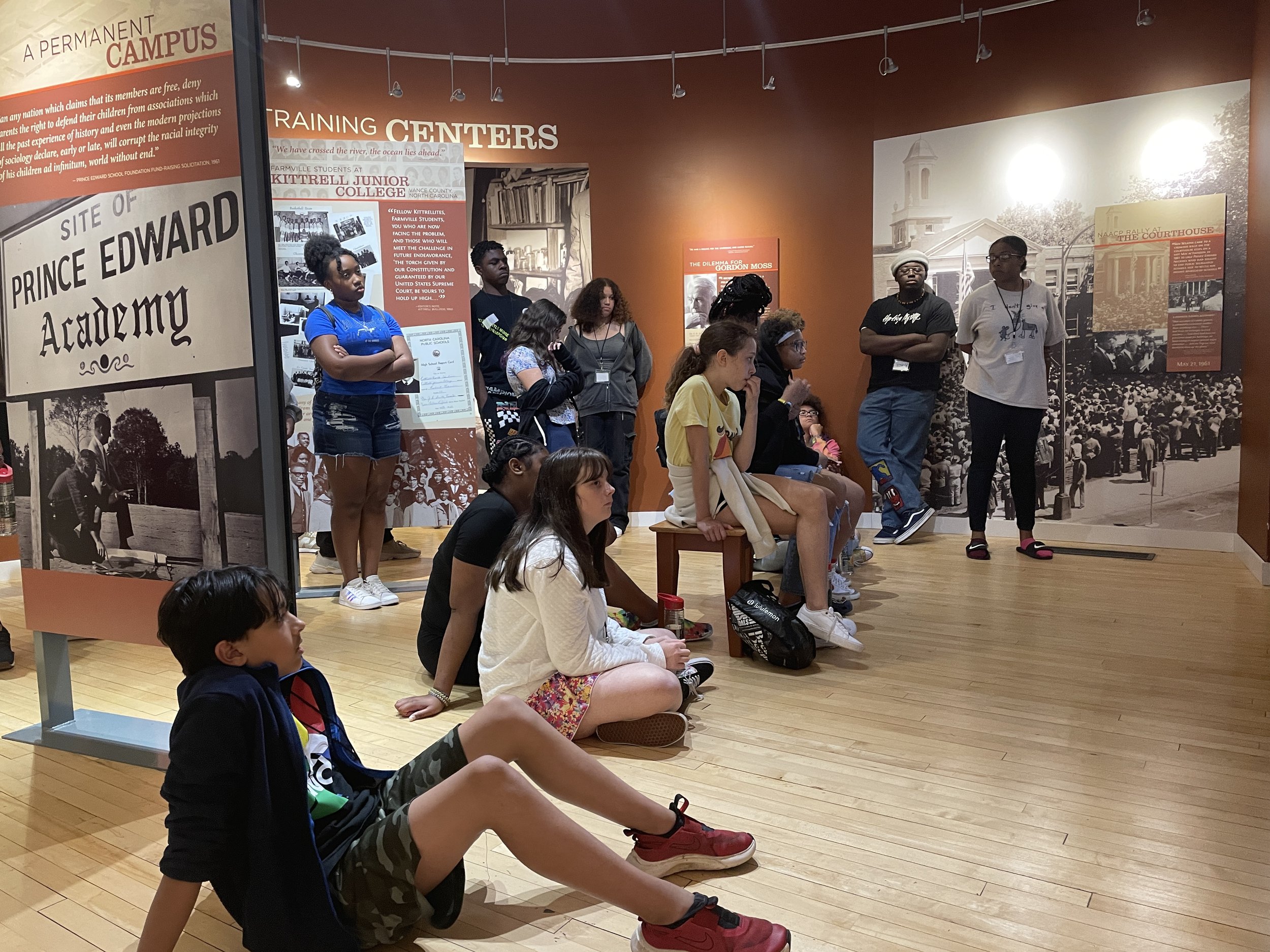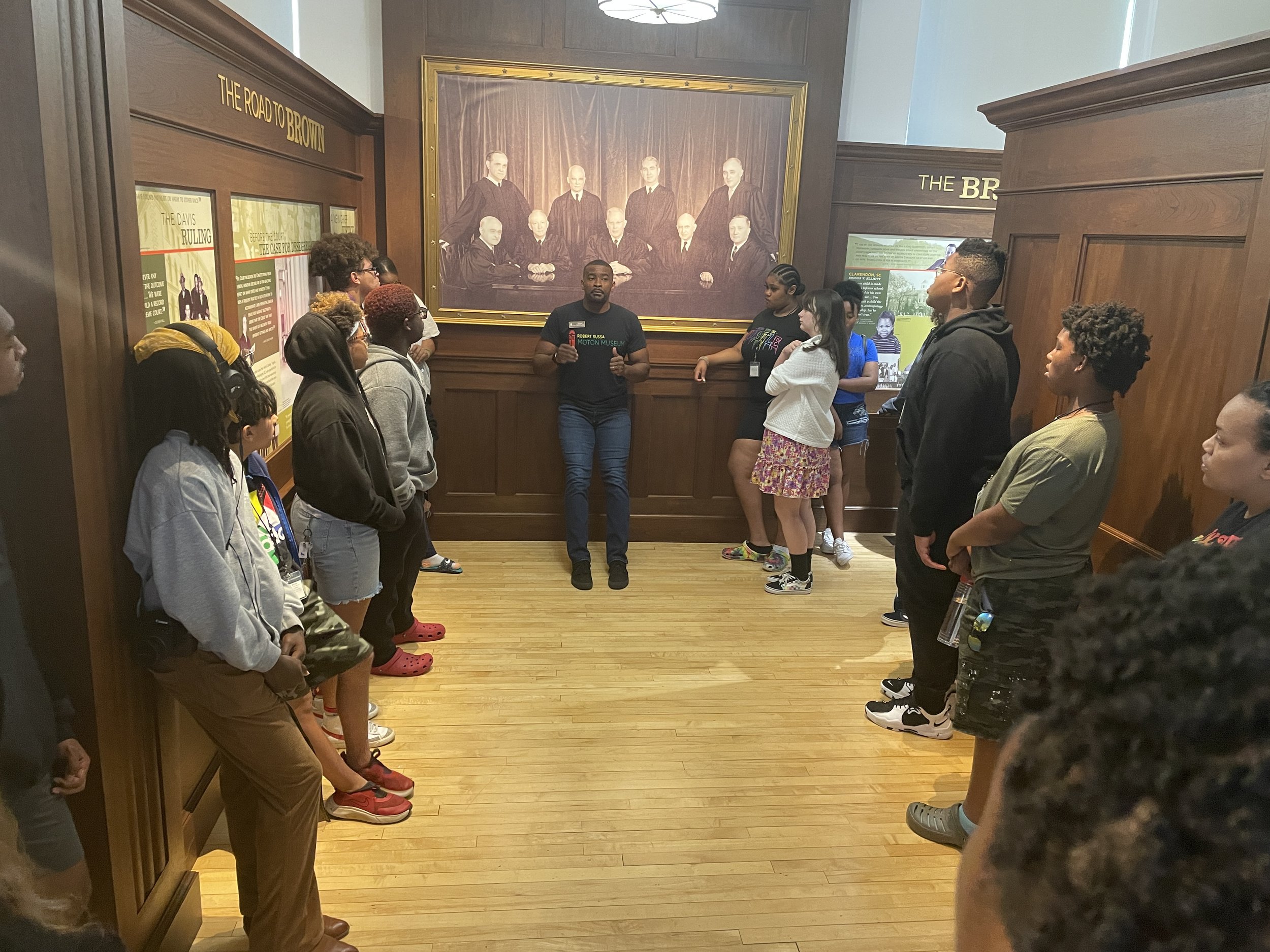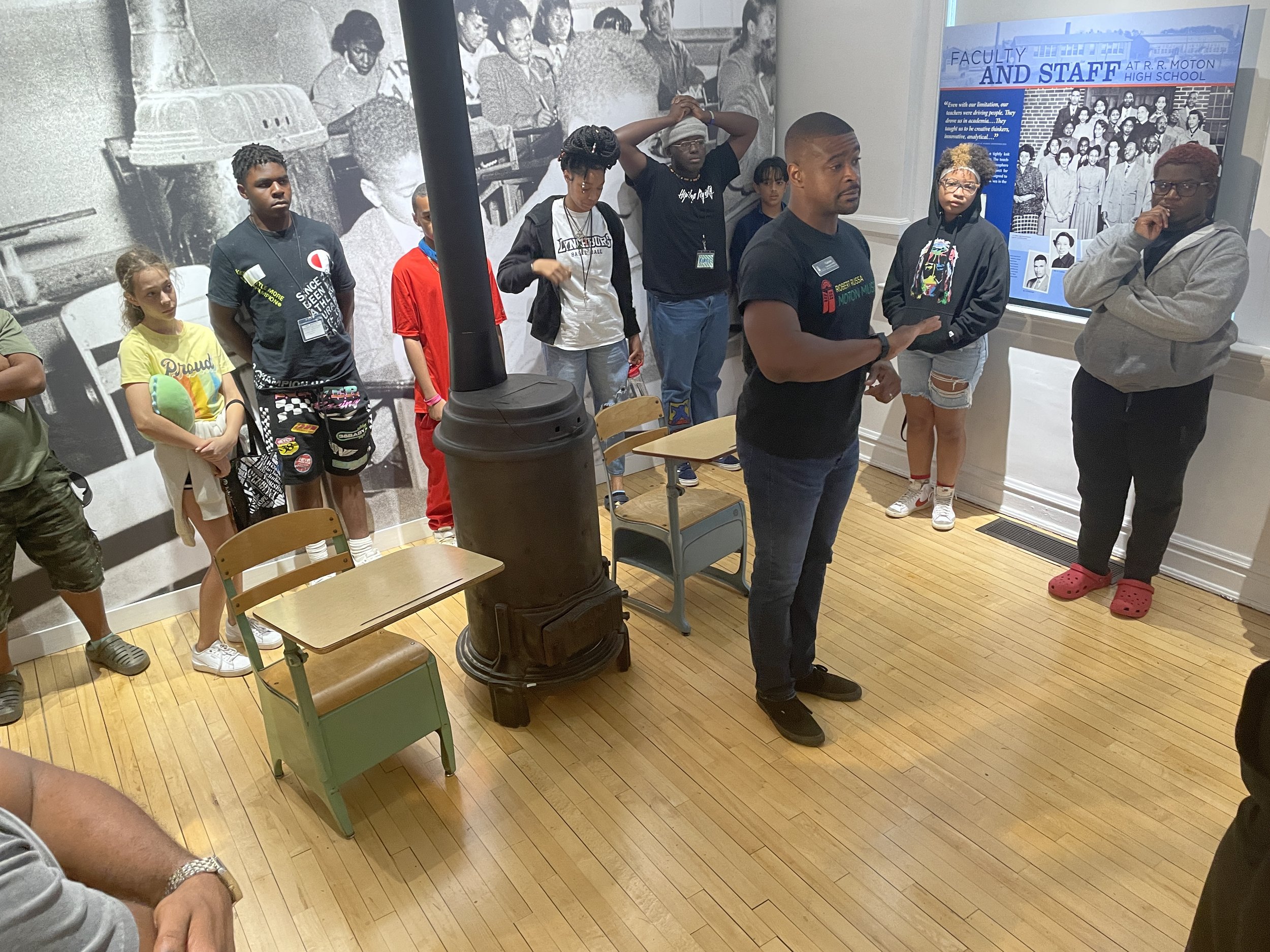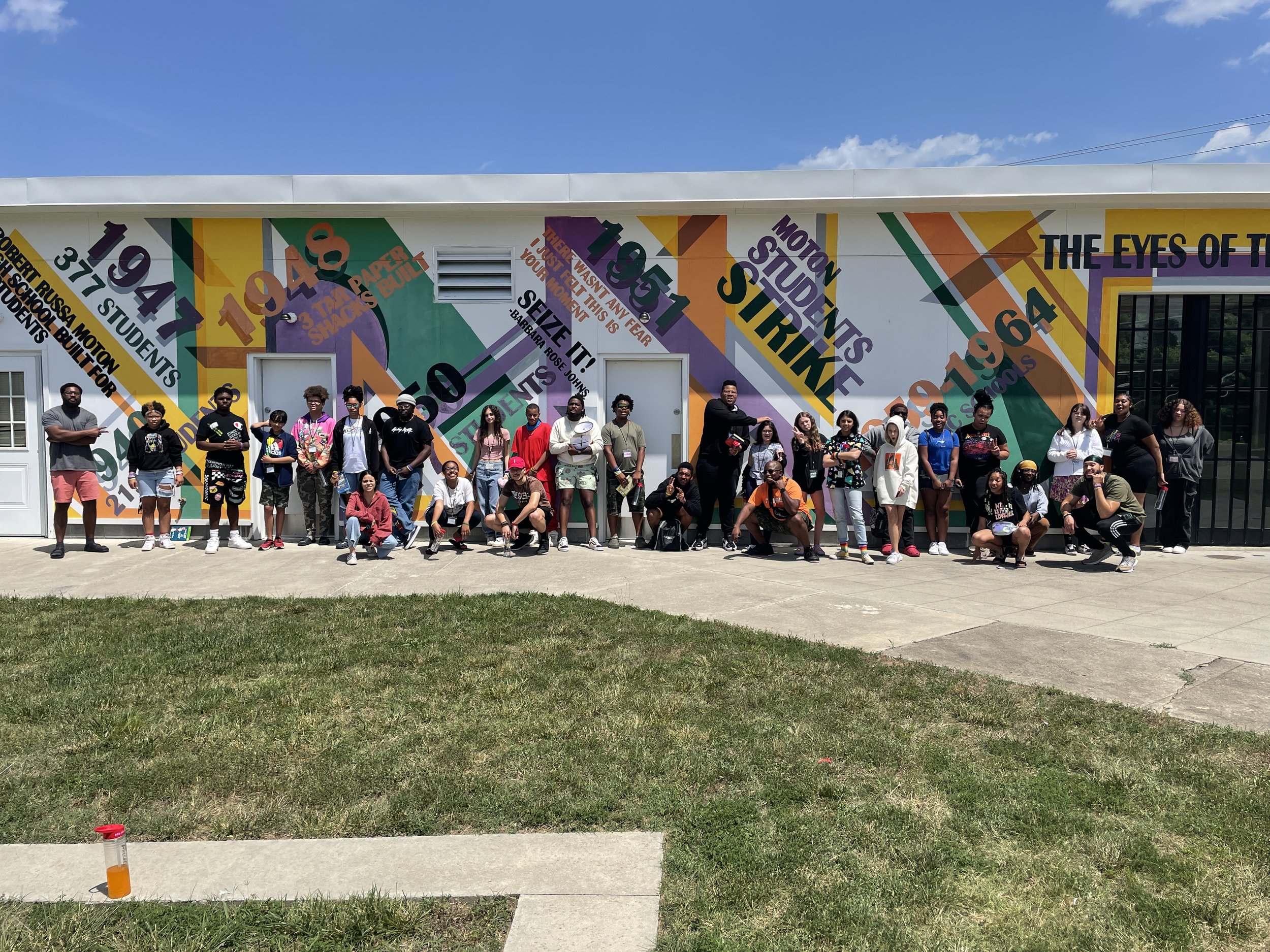A Freedom School Visit to the Moton Museum
Kayden & Lamont
Junior Interns in-Training ‘22
Visiting the Moton Museum as a Freedom School student has shown how tied it was to Freedom Schools across the country. Even now, access to proper education is still unreachable in rural or underprivileged areas- children suffer. In 1951 students in Farmville, VA participated in the Moton Student Strike to have better facilities and equipment. Students in R.R. Moton High, segregated by race from students in Farmville High, had improper tools and resources to get their education. R. R. Moton High was built for 180 students but held 477 and had no athletic field, gym, cafeteria, or science lab. School buildings were made from wood and tar paper- with no insulation. Whenever it rained- students would have to bring umbrellas because of the roof leaks. Hot weather outside would turn their schoolhouses into ovens.
After staging the walkout and strike, they filed a suit against the school board. Their case became one of the five cases featured in Brown v. Board of Education. In 1959, schools were shut down for five years to stop integration, and in 1964, the first Freedom School opened in Mississippi. Their purpose was to educate students about social change and try to register as many African-American voters as they could.
Getting students engaged in the Civil Rights Movement, as well as any other political or economical needs, carried a high significance. These were big goals for their Freedom Summer Project. Despite the outcome of the Brown v. Board case, Mississippi still kept its segregated schools. In 1963, Charles Cobb proposed the idea of Freedom Schools. After Prince Edward County closed its public schools from being sued, Freedom Schools took over. There were a couple of major events involving Freedom School scholars before the first official Freedom School.
Around 3,000 scholars attended a Stay Out For Freedom protest held in Boston in September 1963.
On February 3, 1964, 90,000-100,000 Freedom School students partook in the New York City public school boycott- which was one of the biggest Civil Rights demonstrations in the 1960s.
In 1964, the official year for Freedom Schools, more than 40 different schools were set up in black communities throughout Mississippi. After Freedom Summer was over, teachers and students were committed to the idea of Freedom Schools.
However, despite showing traces of activism and leadership, students didn’t want the schools to continue during the regular school year. Some students in Philadelphia, Mississippi even returned to their schools demanding better resources and courses, getting themselves expelled for wearing “One Man, One Vote” buttons.
On June 17, 2022, we visited the Moton Museum as an educational field trip. It was to learn about what came before Freedom Schools. We learned about the strikes, protests, walk-outs, the “tar paper shacks”, and tragedies. Our guide was even related to one of the students in the protests. We were encouraged to ask questions about these events in history to our parents or grandparents, many of us can be connected in ways we didn’t know. Students, regardless of race or economic background, suffered from the school closings.
People who couldn’t afford to move or pay for Prince Edward Academy simply went without education. Even today, some marginalized groups of people still can’t get the proper education they need, so, this is still an ongoing issue. Learning what was before our Freedom School has impacted how we talk about education because we are privileged enough to have options. Kids have the option to go to Freedom School, to spend their summers reading.
For some students in the ‘60’s, Freedom Schools were their only option. Kids died to learn, read, and protest their right to an education. It is our responsibility as students to learn and educate others on how much this truly impacted history. We still have a long way to go with attaining our educational needs, but through freedom schools and many events and actions throughout the Civil Rights Movement, we are always inching closer. Throughout our trip, we heard the real voices of the real historical figures that fought their way through the Moton school timeline. There were many pictures of these historical figures along with many pictures of students and replicas of many materials used in the real school.
For six weeks in the summer, students learned reading, arithmetic, writing, and history to be educated on how their rights were being infringed upon. Students also learned how to advocate for themselves and become future political figures. Along with supplementing information they lost during their summer break or while school was closed, activism was branched out with each lesson taught.
Like the Freedom Schools before us, this year is no different. Freedom School 2019 highlighted gun violence, 2021 highlighted youth incarceration, and 2022 highlighted climate justice. All of which disproportionately affect communities with poverty and people of color. Across the country, all Freedom Schools fight for the same cause. While many of our schools are no longer segregated, communities are. Subtle things like redlining are very rampant in today’s society. Topics like this aren’t heavily talked about because they’re unknown.
Modern Freedom Schools are crucial in today’s society because older and newer generations’ problems are not the same. Older generations won’t be affected by climate change. The more we advocate for these generational problems, the easier it will be to fix them when they become future problems again. Freedom Schools carry a great significance in fixing these issues. Their solutions are creative and non-violent. Protesting for these issues is not the only way Freedom Schools resolve them. Music videos, books, and community engagement are other options they offer.
Seeing our Freedom School, along with others throughout the country, progress the way they have is a refreshing change for our communities. As Junior Interns, and being with our Freedom School for three years, it’s an honor to be a part of such a positive organization. They have helped us with our academic and economic needs and values. Field trips such as this one are very important for everyone involved with their school, teaching younger generations about how far our world has progressed. It’s important to follow the original goals of Charles Cobb and the first Freedom School: get scholars engaged in their communities with social change. Our National Days of Social Action will always help our economy and scholars while maintaining peace and a healthy environment.
The connection between the Moton story and Freedom School is strong. They were both involved in the Brown v. Board case, going to the supreme court. They both impact history. Freedom Schools across the country continue to prep today’s youth with the resources they need for adulthood and activism. Providing books teaching things about personal finance, social cues, and behaviors, while also preventing “Summer Reading Loss”. Equipping kids with the ability to efficiently raise awareness of their social action theme, demonstrations are safer and cohesively share the message. This year, for example, our Freedom School will be holding a demonstration while being economically conscious. Things like one-time-use poster boards or making wooden signs would be contradictory.
“Freedom Schools should continue until all people, and the planet, are treated fairly and justly.”
Freedom Schools should be worldwide if possible. Places like South Sudan have under 50% of literate people, unlike the U.S, which has the lowest literacy rate of about 80% in California. Places where poverty and unqualified teachers are common need the most help. Children need to know how to read and write, understand the languages they read and write, and advocate for themselves in their own country. Even with the first few Freedom Schools in Mississippi, this would’ve been a pretty tough achievement for students and teachers- especially since the “Separate But Equal” rule had already been established.
The introduction and continuation of Freedom Schools are significant to our future. Advocating and taking action in the things we preach will take us far. This year’s theme in Climate Justice can refresh us on how essential it is to take care of our Earth. After all, it’s the best planet in our solar system that will support living organisms. Social Action and taking care of one another is another big role in life that requires some prioritization.
I believe that our scholars will be able to contribute to social action in their unique ways. Freedom School takes pride in educating and motivating students to speak out about social issues or ideas they may have in their communities. As scholars and Junior Interns in-Training, we have shown traces of our leadership and communication styles. We have started to see various aspects of the world differently than before.
Our eyes have been opened to many new issues, however, we have also been taught solutions to these hardships. Setting an example for our generation and spreading awareness to them is something that we take lots of pride in. We have a long, exciting journey ahead of us involving Freedom School and the Civil Right Movement as a whole.
The sky is the limit for us.





